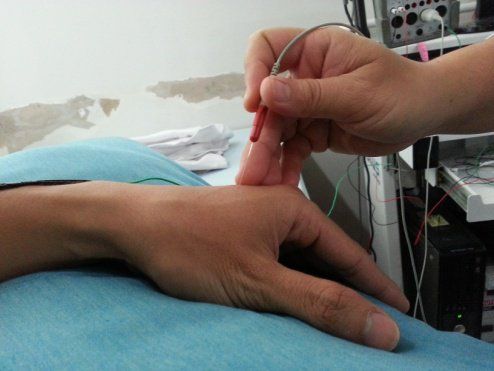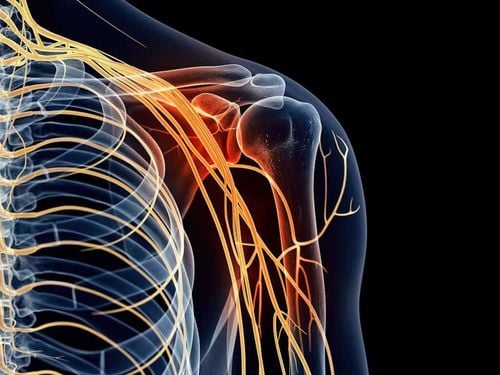This is an automatically translated article.
Posted by Doctor Bui Hanh Tam - Department of Anesthesiology and Anesthesia - Vinmec Times City International Hospital
When nerves leave the spine, they move into the body's tissues and can be clamped or pinched anywhere in its path. Nerves can be chronically compressed due to repetitive activities for a long time or compressed due to acute trauma causing inflammation, edema, fibrosis, and adhesions to surrounding tissues.
1. Common nerve compression syndromes
Common nerve compression syndromes include:
Carpal tunnel syndrome caused by compression of the median nerve, numbness, and paresthesias causing pain in the part it innervates the hand. The piriformis syndrome (pyramidal or pear-shaped muscle), causes pain commonly known as sciatica due to compression of the sciatic nerve by this muscle with symptoms: Pain or numbness in the buttocks, which may radiate down the side. hamstrings, calves, and feet. Pain when walking, running, increased when sitting for a long time such as driving long distances. Elbow tunnel syndrome is caused by compression of the ulnar nerve at the elbow, causing pain in the forearm and hand. Great occipital neuralgia: pain, numbness in the occipital region (neck of the neck), which may radiate upward and higher during acute attacks. Nerve entrapment in the shoulder causes shoulder pain, which is an increasingly common cause, due to heavy backpacking, direct or indirect impact trauma, overuse of the hand, incorrect posture, repetitive posture position.
2. Symptoms
Each nerve has a specific role. That job could be to help muscles move, while also transmitting sensations back up the spinal cord to the brain to notify the signals it receives from the periphery. Some nerves only transmit sensation, while others control both sensation and movement. If a peripheral nerve is injured or pinched, it can prevent you from performing a specific function, such as moving your fingers or toes, or it can cause pain and disturbance in sensation in your body. innervated by that nerve. You may experience numbness or pain or both numbness and pain. If the nerve supplying motor is chronically jammed, it will lead to peripheral muscle atrophy after the jammed site, causing motor function impairment.
The pain is often described as burning, sharp, stabbing or tingling. Usually only one side. Pain due to nerve entrapment is usually dull pain and worsens with movement or pressure.

Kẹt dây thần kinh trên vai gây đau vai
3. Common causes
Peripheral nerve compression neuropathy is caused by a stimulus that causes chronic inflammation or damage to the peripheral nerve anywhere in its path. Pressure on a nerve reduces blood flow to that nerve, causing nerve damage from poor nutrition. Anatomically, any nerve can be trapped. However, nerves that are located near sites of pressure, or near high-intensity muscle groups, or on or close to the bony base, are at higher risk. The medical examination and examination will help the doctor know the location of the pinched nerve based on the characteristic sensory and motor symptoms that the nerve governs.
Nerves that are easily pinched from repetitive activities (such as gym, weightlifting, typing, cycling, jogging, marathon.... can all affect the nerve. Initiation of this process is swelling associated with tendonitis, arthritis or sprain.After acute inflammation, there is healing due to inflammatory reaction but also adhesion of nerves. For example: ankle sprain, which affects the posterior tibial nerve and leads to carpal tunnel syndrome; chronic inflammation of the great occipital nerve, causing headache; chronic inflammation of the occipital nerve on the shoulder causes shoulder pain; chronic inflammation of the inguinal and hypogastric nerves causes pain in the groin area...
After some surgery or procedures the inflammatory process jams the nerve due to the process of scar tissue formation, (such as what happens with some pelvic surgeries, leading to pudendal neuralgia, thoracic surgery, spine surgery, etc.), or due to tumor compression because the tumor is in the path of the cord. nerve, etc.

Các dây thần kinh dễ bị chèn ép từ các hoạt động lặp đi lặp lại chẳng hạn như tập gym, cử tạ, đánh máy, đạp xe,
4. Pain treatment with nerve adhesion procedure
Seeing a pain specialist is a necessary solution because pain caused by peripheral nerve entrapment seriously affects quality of life and reduces work efficiency. During the first visit, the doctor will conduct a thorough history and physical examination to determine exactly which nerve is being compressed or damaged that will explain the cause. From there, the doctor will make a specific plan for treatment depending on the duration of the pain, the nature of the pain, the factors that increase pain, and the pain reliever to decide.
Your treatment plan is a combination of therapies. Your doctor may recommend some lifestyle changes and physical therapy.
If the pain does not improve with these changes, you and your pain doctor can discuss the addition of nerve pain medications. This may include a combination of an anticonvulsant (nerve stabilizer), an antidepressant that also works to stabilize the nerve, and topical patches or creams.
The pain doctor can use a needle to inject drugs to separate the adhesion, release the nerve from the jammed place, and inject nerve blocker to relieve pain under the guidance of a specialized ultrasound machine. , muscle. This is done the same day and the patient can go home to rest after the procedure. This nerve release procedure is performed at the Pain clinic of Vinmec Times City International Hospital.
If you or a loved one is in pain, do not hesitate to contact us for advice. Our goal is to find safe, effective and up-to-date solutions to the world that enhance the quality of your life and work.
Please dial HOTLINE for more information or register for an appointment HERE. Download MyVinmec app to make appointments faster and to manage your bookings easily.













